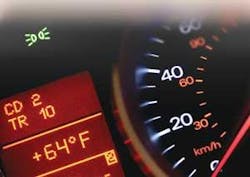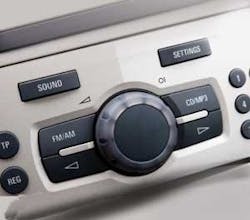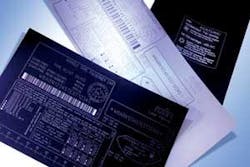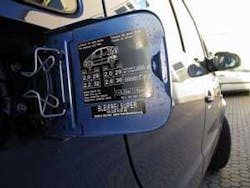Daventry, Northants, UK—Car radio front panels are injection molded, generally in batch volumes, from transparent plastics. The parts are then transported to the paint line, where one side is sprayed, first with an undercoat of white paint and then with a top coat of black paint. The next step in the production process is to remove some of the black paint so that letters and numbers appear white.
A typical laser marking system for such an application consists of a laser head, a control cabinet, and a computer screen and keyboard. Under computer control, the laser beam removes micron-thick layers of the black topcoat in the exact pattern of pre-programmed letters and symbols. There is no mechanical contact, no abrasion, and no pressure. The result is white characters clearly and crisply defined against the black background. At night, these characters are backlit for easy recognition.
One European manufacturer has been using laser marking technology with this type of system from Rofin-Baasel for many years. Working three shifts per day, each laser system completes about 3500 front panels. Changing the markings for a new product is done simply by entering new text or laser parameters at the computer keyboard. If the marking pattern is a repeat, the program is recalled instantly from computer memory.
Reportedly, this marking process was the outcome of successful teamwork between Rofin applications engineers with plastics and paint producers. New paint systems and computer software had to be developed. The technique requires paints that are highly opaque and fast drying so that the different paint layers do not mix. To stand up to the heavy wear on radio controls, the paint must also be highly durable. Customized, high-performance software, designed to handle extensive and special character sets, contributed significantly to the high marking speeds and production rates.
One laser, two marking heads
Typical laser sources for this application are centered around 1064nm and include Nd:YAG, Nd:YVO4, and fiber lasers. The laser beam can be divided equally by a beam splitting mirror and directed simultaneously to two marking heads. Each marking head is equipped with two galvanometer scanner mirrors and a flat-field lens. Splitting the laser beam effectively doubles the productivity of the laser system.
Another factor that enables the high processing speeds is the special lenses that focus the laser beam. The flat-field lens design provides a marking field 230mm in diameter for each head, permitting two radio panels to be marked simultaneously under each lens.
Laser markers must be capable of producing a wide range of characters and symbols in frequently changing combinations. Essential to the efficiency of this whole process is the technique for delivering and directing the laser beam. This task is handled by the two galvanometer mirrors in each marking head that precisely direct the laser beam at constant speed over the surface of the front panel, vaporizing the top layer of paint in the required patterns. In addition to its flexibility, another significant advantage of this beam directing system is its compatibility with a high degree of automation in the manufacturing process.
Laser markers also can be equipped and synchronized with automated handling systems to further enhance productivity. The laser systems installed at this user’s facility are classified as Class 1 systems. This means that all laser energy is confined within the system enclosure. For example, if the machine guarding is opened, the laser system is shut down immediately. Vaporized paint particles are removed by a multi-state air filtration system and during its routine operating cycle, the system produces no harmful particulates or hazardous emissions.
To further ensure safe operation, panels to be marked are fed to the marking stations on rotary indexers or linear indexing systems. The panels are held in position accurately by fixtures that are designed for easy loading and unloading. While the laser is marking one set of articles, the operator removes finished panels and inserts new blanks, in a completely safe operating environment.
Car radio front panels are just one example of a ‘Day and Night’ design produced by laser marking. Others include marking electric window switches, indicator stalks, and around each of the individual control switches on an instrument panel. Any piece of equipment where operating controls must be located and identified under varying light conditions (stereo systems, telephones, and many types of display and control panels) is a candidate.
Tamper-proof laser metal marking
Oxfordshire, UK—Laser marked tamper-proof labels have replaced the traditional metal plaques that were once commonly used for vehicle VIN (Vehicle Identification Number) plates. These plates were generally riveted to the inside of the engine compartment but were extremely easy to remove, thus making it possible to quickly give a stolen vehicle a ‘new’ identity.
Self-adhesive, tamper-resistant labels are made from a laminate foil material and are laser marked.
Manufacturers now use up to 17 separate identity and information labels on a single vehicle, each of which is self adhesive and tamper evident. These new labels are produced from materials that are ideally suited to the automotive, electronics, and security fields. They cure upon adhesion so that they cannot be removed without destroying the label. The labels also withstand high temperatures and are highly resistant to weathering.
This change in the way in which information is attached to the vehicle brought with it the need to develop a robust and high-speed method of producing the new self-adhesive labels.
The TESA laser marking system, from ES Technology, has already been adopted by a number of major automotive manufacturers, including Land Rover, Toyota, and others. The system uses a laminate foil material manufactured by TESA and supplied in reel form. The 120mm-wide reel of material is loaded to a motorized dispensing mandrel on the machine. At the processing area on the machine a pair of pinch rollers, one stepper motor drive and one spring loaded, are used to accurately feed and position the strip material for laser marking.
The system developed by ES Technology to process the TESA material uses a 30W CO2 laser source, which is fully integrated within the machine. Other laser sources, such as Nd:YAG, are offered for alternative materials. The marking process is achieved using a high-speed, servo-driven galvo head, which is located above the working area of the machine.
A built-in extraction and filtration system performs a dual role within this system. The primary task of the extraction system is the removal of fumes and particulate. The extraction system is also used to generate a vacuum under the foil location area to ensure that the material remains perfectly flat during the laser marking process.
When installed within the user’s site, the machines are linked to the user’s data management system, which downloads vehicle and label information directly to the machine, which then automatically populates the fields within the label generation software.



